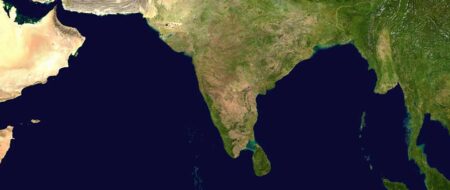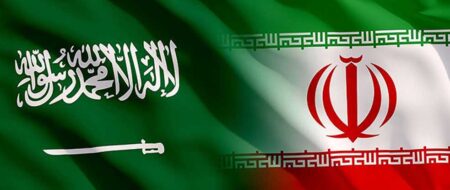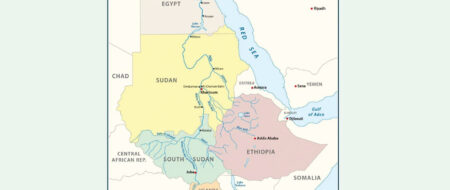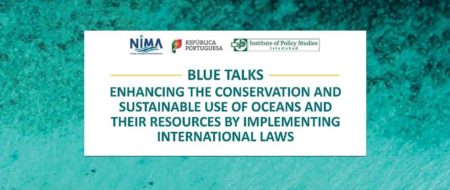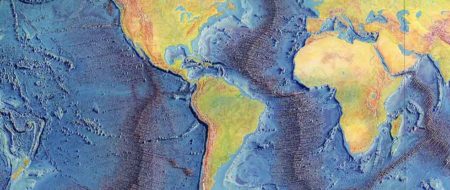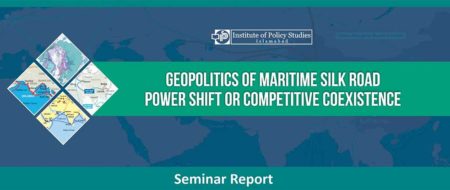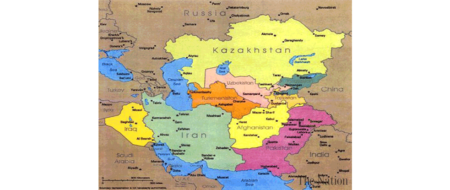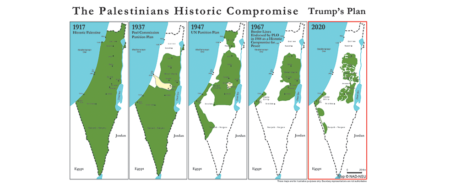South Asian Security: International Context
The regional security scenario in South Asia, previously dominated by always-tense Pakistan India ties and resultant huge nuclear and conventional armed build-ups, has been drastically changed owing to the post 9/11 events and developments
Policy Perspectives, Vlm 3, No.1
Abstract
[The regional security scenario in South Asia, previously dominated by always-tense Pakistan India ties and resultant huge nuclear and conventional armed build-ups, has been drastically changed owing to the post 9/11 events and developments. The less overt yet pervasive activities of the extra regional players are becoming more visible under the guise of the US led “war on terrorism”. The US actions against Afghanistan have created multifarious challenges and numerous threats for Pakistan detrimental to the stability of the entire region. Pakistan’s post 9/11 policy, coupled with India’s gaining an extended foothold in Afghanistan, has multiplied external threats for Pakistan in terms of the low intensity conflict on the western borders. Domestic political complexities and divisions have also increased manifold in Pakistan. India’s profound interests in the Gulf financial centers and the US bitterness against Iran are heavily contributing towards deteriorating security situation in Balochistan, the province that is being developed with Chinese assistance and sizeable investment. The deepening US-India strategic relationship, particularly in nuclear filed, hardly bodes well for the regional security. Pakistan needs to gauge and closely monitor the US objectives in this backdrop. – Editor]
South Asia’s security dynamics till 9/11 stemmed primarily from indigenous roots, with external factors impacting and, on occasions, aggravating or distorting them. The relevance of South Asian security in the international polity, during the cold war period, essentially revolved around conflictual Indo-Pakistan relations, Sino-Indian relations and the issues relating to nuclear proliferation.
For instance, the strategic disunity of South Asia was premised primarily on the conflictual Pakistan-India relationship and the imbalance of power in the region with the major power India involved in conflicts with all her neighbours at one time or another. The Cold War and bipolarity did not alter these dynamics, although they were reflected in the region with Pakistan closely allied to the US and India to the Soviet Union. In the post Sino-Indian conflict period, the US made inroads into India through military and economic assistance and China began getting closer to Pakistan. However, the wars in the region between Pakistan and India had their bases in the conflicts inherited with the creation of the two states in 1947. The creation of Bangladesh in 1971, certainly had Soviet support for India in the background and US acquiescence to the break-up of Pakistan – and the P5 dynamics of the Security Council also played a role in preventing an effective ceasefire resolution before the fall of Dhaka.[1]
In the recent past, the limitations of extra-regional or global influences was most starkly reflected in the overt nuclearisation of South Asia in May 1998, with the nuclear tests by India followed by those of Pakistan – in the face of strong international censure.[2] In fact, Pakistan’s nuclear history reflects the criticality of the bilateral strategic equation for the country and the limited influence even super powers can have on policies directly impacting this equation.
However, in the face of the nuclearisation and the missile development in South Asia, one was beginning to see the sub regional Asian divides move towards dissipation especially given the extensive missile programme of India, which has enhanced its operational capability to include East and West Asia within the striking range of its missile deployments.[3] The growing military dimension of South Asian security has raised the stakes of major International actors in peace and stability of this region. The US intervention in the Kargil conflict in 1999 – in the form of pressure on Pakistan was reflective of this fact. There were speculations, later proven wrong, that if the conflict was not curtailed, exchange of nuclear weapons was a possibility. The region was then termed as the most dangerous place on earth, thus drawing the attention of the international community to the need for resolving Indo-Pakistan disputes.
But the events of 9/11 have altered the strategic milieu of South Asia with a greater intrusiveness from extra regional players, especially the US through its war on terrorism. Despite its much proclaimed victory in Afghanistan, the overall result of the present US war on terrorism has destabilising effects on many parts of Asia because of the following reasons:
One: It has altered the internal dynamics within the societies of many of the countries in the frontline of the war on terror.
Two: The US pre-emptive doctrine, with its focus on regime change as one of the rationales for a pre-emptive intervention by the US, has destabilised many governments and rulers in Asia, primarily in the Middle East – but threatening to do so in Central Asia and beyond also.[4]
Three: States in the forefront of the war on terror, such as Pakistan in the war being conducted in Afghanistan, have had to suffer political consequences domestically as well as economic costs.
Four: The war on terrorism is focusing on targeting the symptoms only without hitting the root-causes. This strategy would make the continuation of war against terrorism an end itself, rather than eliminating the menace of terrorism.
Perhaps the greatest shift in the security dynamics of South Asia as a result of the new US-led war on terrorism has been the now intrusive interest of the US in South Asian security dynamics. Add to this the linkage between South Asia and Afghanistan through the war on terror and for the first time we see external factors directly impacting the security dynamics within South Asia.
The shifts in great power projection and the post-9/11 emphasis in battling terrorism and dealing with the issue of WMD – as well as the pre-emptive doctrine – have all had varying effects upon the regional dynamics – especially in terms of the Pakistan-Afghanistan relationship on the one hand, and the Pakistan-India relationship on the other – and these have been impacted upon by US policies and the emerging Indo-Israeli-US relationship which is viewed by Pakistan as a strategic nexus.[5]
Post-9/11, Pakistan became a frontline state once again for the US – this time as a partner in the US-led War on Terrorism. This has had an effect on the internal dynamics of state-society relations within Pakistan’s tribal belt along the border with Afghanistan. The Pakistan Army’s opening up of the tribal areas and the launching of operations to hunt out foreign fighters has created mixed results with long term political implications for the country.[6]
The occupation of Afghanistan by US-supported Northern Alliance, following the fall of Taliban, provided India with an opportunity to consolidate its position in Afghanistan. India has opened consulates in Afghanistan, including along the border towns like Kandahar and Jalalabad. For Pakistan, this has presented the possibility of Low Intensity Conflict (LIC) being conducted inside Pakistan from its Western borders.[7]
In fact, one direct fallout of the war on terror has been the new interest being shown covertly by external powers over the development of Balochistan – the Pakistani province bordering Iran and Afghanistan – especially its port city of Gwadar. As the scale of terrorist attacks in Balochistan become more extensive, it is clear that these acts of sabotage are not random but have careful planning behind them – as well as a certain level of technical sophistication. And of course there is the very important financial aspect. All these indicators prove the strong external linkages to what is happening in Balochistan.
This is not to deny the prevalence of local discontent which is primarily linked to a sense of economic deprivation and lack of a political voice, but the external factor is of major importance here. The development of the Gwadar port, of course, allows Pakistan and China very concrete economic opportunities including the opening up of a trade[8] corridor with a reach to Central Asia.[9] If Gwadar and its surrounding areas develop, business can be attracted here away from some of the prevailing Gulf financial centres – where India has very heavy financial stakes. Here the economic interests of India become enmeshed with the interests of the Gulf States.[10]
Nor is the relevance of Gwadar merely economic, although presently for Pakistan and China, that is the prime objective. In the long run the strategic importance of Gwadar has multiplied post-9/11 because of the increased US presence in the region – both in the Gulf and in Central Asia.[11] To suddenly have a strategic port at Gwadar, uncomfortably close to the main US overseas base in the Gulf, to which China would have access, becomes an unacceptable notion for the US which sees the containment, and probable encirclement, of China as a long term strategic objective.
Then there is the issue of energy security and US efforts to keep control of energy resources in Muslim states and societies, from the Middle East to Central Asia. India is also investing heavily in the energy resources of Central Asia and there was news in early January 2005 that the Saudi oil giant Aramco was thinking of going into a strategic alliance with Indian Oil Companies.[12] Now, Afghanistan has also offered to export its gas to Pakistan and India. For both the US and India, the pipelines projects through Pakistan allow Chinese energy needs to be met more efficiently.[13] India and the US have reached an agreement to take the responsibility for securing the sea-lanes of communication from Straits of Hormuz to the Straits of Malacca.
However, more important for the US, it would like to isolate Iran within the region even as it increases its rhetoric against Iran on the nuclear issue. We have seen US Vice President Cheney declaring, on January 20, 2005, that Israel might “act first” against Iran[14] and Condoleezza Rice declare that Iran must be made to understand that it cannot pursue its nuclear ambitions.[15] (At the same time Israeli Defence Minister Mofaz told French law makers that Iran had reached “a point of no return” on building nuclear weapons – an ironic statement given Israel’s own clandestine nuclear weapons programme. Is it merely a coincidence that as the US rhetoric against Iran has increased in belligerency, the acts of sabotage in Balochistan have increased in frequency and intensity? If Iran is attacked, it will destabilise the region and have grave consequences for South Asian security.
Here, nothing would suit the US better than to aggravate Pakistan-Iran relations – by planting rumours/suggestions that somehow Iran was involved in the violence in Balochistan and thereby compelling Pakistan to seal the Pakistan-Iran border in a fashion similar to the Pakistan-Afghan border situation. Also, given that the US continues to toy with the idea of a military strike against Iran, the US thinking, based on an amazing sense of naiveté, seems to be that somehow if there is suspicion and animosity created between Pakistan and Iran, its actions against Iran will have no fallout in Pakistan. It should realise that no matter what the state of the Pakistan-Iran relationship, any military attack against Iran will be seen as a precursor to an attack against Pakistan’s strategic assets. Any such US military action will also make it even more difficult for Pakistan to cooperate with the US on strategic issues. Interestingly enough, at present it is certainly not in Iran’s interests to have a destabilised Balochistan, given its growing problems with the US and instability on its other borders, especially within the Iraqi context. As long as Balochistan remains unstable and the law and order situation remains uncertain, the true potential of Gwadar cannot be realised. And the Chinese will certainly be compelled to take a second look at their growing economic commitment in Pakistan. The Chinese were moving in a big way into the Pakistani market, especially in terms of investment in the industrial sector. By creating a law and order situation, the Pakistani market can be denied to the Chinese.
For the US there is a much wider context to what is happening in Balochistan. This is linked to its efforts to redraw the map of the Muslim World in the Middle East and West Asia – what is now being referred to as the “Broader Middle East.”[16] Breaking up larger Muslim states, redrawing borders between some of them, creating new political entities – all these are part of the new strategic game plan which will have serious implications for the South Asian security as well.
Another external factor that will impact the security dynamics of South Asia is the presence of NATO in Afghanistan.[17] This is a new expansion of the NATO operational framework and could lead to a new involvement of NATO in Asian security matters. With NATO on its borders, countries like China and Pakistan have to study the implications for its long-term security.
In the Pakistan-India context, for the first time external powers have directly impacted the security dynamics between these two states, on a number of counts.
· The failure of India’s policy of brinkmanship which began with the mobilisation of forces along Pakistan’s border in December 2001, not only led to a greater intervention by the US in the region, but also resulted in direct US pressure on India to de-escalate and move towards dialogue with Pakistan.[18]
· The US and the international community showed a recognition that they had a direct stake in peace between Pakistan and India, given the nuclear context.[19]
· There has been a growing effort to devise some means of accepting the reality of a nuclear South Asia in order to bring Pakistan and India into the non-proliferation mainstream. The whole Dr. Khan and European associates’ proliferation network along with reported thefts of nuclear material in India and the prevalence of a suspected ex-Soviet scientists’ nuclear network, have all shown the need to strengthen the nuclear safety dynamics in the region.[20]
· In a contradictory move, the US is upsetting the stability of the nuclear deterrence in South Asia by committing to supplying India with Missile defense systems and other state of the art weapons technology – all of which directly undermines Pakistan’s stated policy of minimum nuclear deterrence and nuclear restraint. That is why Pakistan has expressed concern over the Phalcon sale to India since this directly destabilises the strategic nuclear balance established in South Asia. The Phalcon sale to India is part of a massive US-India strategic partnership, which has a strong defence component – and is linked to the Indo-Israeli relationship, which centres on defence cooperation. The US-India relationship directly impinges on the US-Pakistan relationship because of the defence aspects whereby the transfer of certain weapon systems to India impacts on the security threat perceptions of Pakistan. With the prospects of the transfer of the Arrow system also to India, clearly the deterrence will be moved to higher level of armaments being held by both sides.
The issue of WMD has had a direct impact on Pakistan, not only on the so-called Khan network, but also because the focus on non-proliferation has been replaced by a focus on the weapons of mass destruction (WMD) programs of particular states. The result has been the undermining of the existing nuclear non-proliferation structures and treaties and the increasing politicisation of the issue. Additionally, the WMD issue has become a central rationalisation for the US pre-emption doctrine – in military terms. At the same time, the US itself is now seeking to rationalise the military use of nuclear weapons through its Nuclear Posture review of 2002 and the Congress sanctioning the production and testing of low-yield nuclear weapons. This new notion of nuclear weapons – that is, as militarily viable – will impact the whole nuclear arms control and disarmament debate.
Interestingly, this new focus on WMD has pushed both Pakistan and India into looking more towards regional stability arrangements in the nuclear field with dialogue to commence on nuclear CBMs. Already Pakistan and India have an agreement relating to non-attack against each other’s nuclear facilities – a list of which is exchanged on a yearly basis and has continued even during periods of heightened tensions. There is now talk of nuclear risk reduction centres, greater transparency and so on. The latest CBM in this field has been Indian consent on a Pakistani proposal to have an agreement on pre-notification of missile tests.
While Pakistan and India have had their bilateral security compulsions impacted upon by external powers, especially the US, post-9/11, we have seen other external players also become more active in furthering peace processes in South Asia – with the Norwegians actively seeking to play a role in resolving the Tamil conflict in Sri Lanka.
Has the South Asian security framework benefited from these external interventions? At one level, yes. The active interest of the international community in pushing for peace in South Asia has had a positive impact on the major South Asian players. However, the military relationship between the US and India has added a new dimension to Pakistan’s security equation – thereby aggravating its security perceptions.
The signing of the New Framework for US-India Defence Relationship by the defence ministers of the two countries in Washington on June 28, 2005, marked the commencement of a ‘new era’ in their evolving strategic partnership.[21] The Manmohan Singh visit built on this and we saw a unique nuclear agreement being signed between India and the US which effectively puts paid to the international non-proliferation agenda, since it effectively recognises India’s nuclear weapon status. It does so by seeking to separate Indian military nuclear facilities from the civilian facilities which India, as a quid pro quo, will now place under IAEA safeguards. Linked to all this is the US commitment to provide nuclear technological assistance to India.
For those in Pakistan who still long for a strategic partnership with the US, the recent ten-year military agreement between the US and India should be a clear indication of the global and regional realities confronting Pakistan. Clearly, a long term strategic relationship with the US is not part of this reality. Taking some of the central factors of the Indo-US defence agreement one by one, the fallout for Pakistan can be assessed more clearly. The most important, both in the short term and long term, is the Indo-US agreement to cooperate on missile defence (MD).[22] Acquisition of missile defence capability by India directly destabilizes the nuclear deterrence in South Asia as well as undermining Pakistan’s doctrine of minimum deterrence and nuclear restraint. To sustain a credible deterrence Pakistan will have to begin multiplying its missiles and warheads very soon – as well as deploying its nuclear arsenal in a scattered fashion into the interior of the country. While there is no need for a direct arms race, but the “minimum” will be moved to a much higher level unless Pakistan is able to also acquire missile defence capability – which does not seem likely for quite some time.
So what the Indo-US plan is doing is to undermine the strategic stability not just in South Asia but in the East Asia region also. This instability is further heightened by another of the components of the Indo-US defence agreement – that of activating the Proliferation Security Initiative (PSI) in this region with India becoming a partner. The PSI is part of the US notion of “coalitions of the willing” which seeks to undermine prevailing international law – in this case the law of the sea – by attributing to members of the coalition the right to stop traffic on the high seas and in international airspace on a mere hint of suspicion of transportation of WMD material or components. One does not require too much wisdom to see how this pretext can be used to harass other states and their nationals – especially given that there is no provision of compensation for wrongful interventions!
While many states would like to be part of the PSI, they have to be asked by the US and so far Pakistan seems to have been left out – which should show clearly how absurd is the Pakistani claim of having a strategic relationship with the US. But then in relation to Pakistan, the US is targeting its nuclear capability through one ruse after another and one can be sure that the MD and PSI components of the Indo-US agreement all aim to delink India’s nuclear status from that of Pakistan.
Beyond the MD and PSI aspects, there is the element of joint weapons production between the US and India which implies transfer of state-of-the-art technology to India. This also includes joint military research and development projects. This again will put pressure on Pakistan in terms of its nuclear and conventional weapon systems. Most critically buying American now would make little sense because whatever Pakistan acquires – once it has managed to move past Congressional blockades – would be undermined because India would have a better counter to that system from the US. The US has also committed to India for transformative systems in areas such as command and control and early warning. These will then become force multipliers for India and again put pressure on Pakistan’s weapon systems.[23]
In view of these developments, Pakistan should re-evaluate US intent towards Pakistan including in terms of its nuclear status. Undoubtedly, having delinked India from Pakistan on the nuclear issue, one should expect a more concerted and overt program targeting Pakistan’s nuclear assets. As for any remaining myth about Pakistan having a strategic partnership with the US, let that be removed once and for all in the light of the Indo-US defence and nuclear agreements.
Also, the presence of NATO will raises serious concerns for Pakistan and China. Finally, the internal impact of the increasing interventionist policies of the US on Pakistan has become a major factor for instability within civil society – whether it is in Balochistan or the tribal belt. Unless this impact is contained, it could aggravate the strategic milieu of Pakistan.
All in all, the post-9/11 dynamics of the security environment of South Asia have altered in that external players are creating new dimensions to the existing indigenous issues.
[1] For detailed account see: “Role of Other Countries.” by Lt. Gen. Kamal Matinuddin in Tragedy of Errors: East Pakistan Crisis 1968-1971. Lahore; Wajidalis. 1993. pp.303-325.
[2] On June 23, 1999 President Bill Clinton sent General Anthony Zinni, Commander-in-chief of Central Military Command and Deputy Assistant Secretary of State for South Asia G. Lanpher as personal envoys to Islamabad, where they met with Prime Minister Nawaz Sharif, Chief of Army Staff General Pervez Musharraf and other important government officials. General Zini conveyed him a message from the American president asking Pakistan to withdraw its forces unconditionally from Kargil. Zinni implicitly threatened, “The US would not bailout Pakistan if India decided to launch a major attack across the Line of Control.” The US also threatened to block a $100 million tranche of an IMF loan to be disbursed to Pakistan soon. The G-8 countries sent an even tougher private message to Sharif threatening to suspend all multi-lateral and bilateral aid. The Pakistani side demanded of the Americans to adopt a balanced Indo-Pak policy, and do not de-link Kashmir and the Kargil from each other. Sabur, Abdus. “The Kargil Crisis: An Overview.” www.arts.monash .edu.au. Nov. 7, 2004. http://www.arts.monash.edu.au/mai /savirtualforu m/Paper Sabur1.htm
[3] The Indian Defense Research and Development Organization (DRDO) was established in 1983 under the direction of Abdul Kalam to develop ballistic missiles. Now, India’s program is considered to be one of the most ambitious missile programs in the developing world, capable of producing missiles with ranges equal to those deployed by the original five nuclear powers (United States, Russia, China, England, and France). Many analysts consider India’s ballistic missile program a derivative of its space program which is rated by some as one of the most advanced programs among emerging missile nations. A list of Indian missiles is as follows:
|
Missile |
Range |
Payload |
CEP |
|
Prithvi I |
40-150 km |
800 kg |
50 m |
|
Prithvi II |
40-250 km |
500-750 kg |
75 m |
|
Prithvi III |
40-350 km |
500-750 kg |
unknown |
|
Dhanush99 |
40-250 km |
500-750 kg |
75 m |
|
Agni I |
2500 km |
1000 kg |
100 m |
|
Agni II |
3000-3500 km |
1000 kg |
100 m |
|
Agni III |
5000 km |
unknown |
unknown |
Source: South Asia Program: The International Institute For Strategic Studies (IISS), London. Available at http://www.iiss.org/showdocument.php?docID=643
[4] In the wake of the September 11, 2001 attacks on the US mainland, President G. W. Bush set out a foreign policy doctrine based on a willingness to take pre-emptive military action against ‘rogue states’ and terrorist groups before they struck out at the US or became an unmanageable future threat. The clearest example of this doctrine in practice was the March 2003 invasion of Iraq. For details see: The U.S. Doctrine of Preemptive Attack – Real Problem, Wrong Answer. Report of the Task Force on Peace and Security, United Nations Association, National Capital Area, June 17, 2003. available at http://www.comw.org/qdr/ fulltext/0306deantf.pdf.
[5] Blankfort, Jeffrey. “The Indo-Israeli-U.S. Axis (of “Evil”?).” OutlookIndia.com, May 19, 2003.
[6] Pakistan has seven tribal areas, known as Federally Administered Tribal Areas (FATA).These are Khyber Agency, Mohmand Agency, Orakzai Agency, Bajur Agency, Kuram Agency, South Waziristan Agency and North Waziristan Agency. All seven are situated in North West Frontier Province (NWFP), on the Afghanistan border. According to a 1998 national census, the FATA has a population of nearly 5.7 million. And its approximately 27,220 square kilometers include a porous border of 450 kilometers with Afghanistan. The tribal areas are often described at being “beyond the writ of the federal government.” This is true in a strict legal sense. No Pakistani laws apply in the FATA. It has a separate code called FCR 40, a legacy of British rule devised in 1901 and perpetuated on partition. At the insistence of the US, Islamabad sent thousands of troops to track down foreign fighters. But instead of being welcomed and assisted by the tribals, they encountered bitter resistance, and scores of soldiers were killed and armed operation is still continuing.
[7] India has opened Consulates in Kandahar, Jalalabad, Mazar-e-Sharif and Herat, besides having an oversized diplomatic mission in Kabul when there is not much tourist travel between the two countries. Kandahar and Jalalabad are near the borders of Pakistan, which insinuates many things. The ongoing Wana operation is being fed cash, weapons and ammunition indirectly by these RAW operatives under cover of Al-Qaeda. Iran, having contiguous borders with Pakistan, is a hotbed of intrigues and constant source of support and inspiration to RAW functionaries. The Indian Embassy at Tehran and Consulates in Zahidan, Mashhad and Bandar Abbas are actively engaged in establishing links with disgruntled elements of Balochistan and Sindh for destabilizing these provinces. (Hali, S. M. “RAW’s summer offensive fomenting sectarian trouble in Pakistan.” Available at http://www.infopak.gov.pk /writeups/writeups _english/2004/july/RAW_summer_offensive.htm)
[8] The Gwadar project came about as a result of a Sino-Pakistan agreement in March 2002, under which China Harbor Construction Corporation is building the port. By virtue of its excellent location, Gwadar port is also visualized to become a regional hub serving incoming and outgoing commercial traffic of the Middle Eastern and Gulf countries, the Xinjiang province of China, Iran in the west and Sri Lanka and Bangladesh in the south and east. Its location at the mouth of the Gulf and at the opposite end of the strategic choke points of Straits of Hormuz and the Gulf of Oman enhances its strategic importance. Its development could favorably influence the geo-strategic environment of the region and have an overall beneficial impact on Pakistan. Lying in the vicinity of oil-rich Gulf States, Gwadar could also be a potential source of offshore gas and oil exploration. The existing highways on the Afghan border, connecting the border towns of Chaman and Torkham provide the shortest all-weather road and rail links to Gwadar. (Masood, Talat. “Gwadar’s strategic importance.” Available at http://www.despardes.com/ articles/ feb05/ gwadar.asp
[9] Chief Minister of Balochistan, Jam Mohammad Yousuf has said that the involvement of external elements, including the Indian intelligence agency, Research and Analysis Wing (RAW) in the recent acts of terrorism could not be ruled out. Defending the construction of Gwadar port and cantonments, he put the blame for the deteriorating law and order situation in this important province of Pakistan on anti-Pakistan elements. The Indian consulates being allowed by the present Afghan government which are working in Kandhar, Jalalabad, and other cities of Afghanistan have also been converted into training camps for RAW agents. Many agents of this Indian intelligence organization involved in acts of terrorism were caught red handed with arms and maps of important defense installations on the Pak-Afghan border. (“Causes of terrorism in Balochistan?” The News. (editorial), Sept. 1, 2004)
[10] For in-depth study see; Mazari, Shireen M. “Balochistan and the ‘great power games’.” The News. Islamabad, Feb. 2, 2005)
[11] Ibid.
[12] Ibid.
[13] Ibid.
[14] Ibid.
[15] Rice says diplomacy can solve Iranian crisis: In an interview with the French weekly Le Figaro magazine published, Rice said it was important that the world united to make Iran understand that it cannot pursue its nuclear ambitions while being an active member of the international community. (The Nation Islamabad, Jan. 29, 2005)
[16] Aruri, Naseer. “Remapping the Middle East: Whose war is it this time?” Available at: http:// www.tari. org/remapping_the_middle_east.htm.
[17] Tyson, Ann Scott. “NATO Plans Afghan Presence.” Washington Post, June 2, 2005; Available at: http://www.washingtonpost.com/wpdyn/content/article/2005/06/01/AR2005060101724.html
[18] USA Today, Oct. 18, 2004. Secretary of State Powell has confirmed this in an interview saying he scripted the Pakistan-India thaw.
[19] “Kashmir: A Nuclear Flashpoint – Challenges and Responses.” Paper presented by Dr. Shireen M Mazari, DG, ISSI in the International peace conference ‘Towards Stability, Peace and Justice in South Asia’ organised by Justice Foundation, Kashmir Centre, London from October. 25-26, 2004.
[20] It is said that unlike Pakistan, India has a record of non-proliferation which is exceptional. It has very strong commitment to protection of fissile material, other nuclear materials and nuclear technology. But fact says otherwise. In 1975, India signed a nuclear cooperation agreement with Iran and began helping in the completion of the Bushehr plant between 1980-1983, including the sending of nuclear scientists and engineers to Iran in November 1982. In 1991, despite US opposition, India negotiated the sale of a 10-megawatt nuclear reactor to Iran and, as we all know, Dr Prasad worked in Bushehr after he retired in July 2000 as head of the Nuclear Corporation of India. It is no wonder that Iran’s top nuclear negotiator, Hasan Rowhani, visited New Delhi for talks with the Indian Prime Minister in February 2004. And that is not all. In 1992, India also supplied thiodyglycol, and other chemicals, to Iran; and in 1993, United Phosphorous of India supplied Iran with 30 tones of trimethyl-phosphite. It is also known that an Indian company exported chemicals to Iraq for Saddam’s missile program and a director of that company, Hans Raj Shiv, was under arrest in New Delhi. And no one is talking much about the presence of retired Indian nuclear scientists in Libya. (Mazari, Shireen M. “The writing on the wall.” The News, Islamabad, July 27, 2005)
[21] The United States and India signed a 10-year agreement paving the way for stepped up military ties, including joint weapons production and cooperation on missile defense, greater sharing of technology and intelligence as well as an increased trade in arms. Titled the “New Framework for the US-India Defense Relationship” (NFDR), it was signed on June 27, 2005 by U.S. Defense Secretary Donald Rumsfeld and India’s Defense Minister Pranab Mukherjee. The statement said that the United States and India had “entered a new era” and declared that the two countries’ defense relationship had advanced to “unprecedented levels of cooperation.” (Gentleman, Amelia, “New era’ on defense for India and U.S.” International Herald Tribune, June 30, 2005)
[22] Ibid
[23] Mazari, Shireen M. “Indo-US scheme of things.” The News, July 06, 2005.


